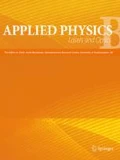Abstract.
The heat produced in conjunction with the processes of stimulated Raman scattering and four-wave Raman mixing in hydrogen was measured by photothermal refraction spectroscopy. Many vibrational, rotational, and vibrationally shifted rotational Raman lines are exclusively/simultaneously generated by changing the polarization of the laser beam and the hydrogen pressure. Thermal loss occurs predominantly from vibrational Raman scattering, which can be ascribed to a large Raman shift frequency of 4155 cm-1 for the vibrational transition. In contrast to stimulated Raman scattering, little or no thermal loss is observable during the process of four-wave Raman mixing.
Similar content being viewed by others
Author information
Authors and Affiliations
Additional information
Received: 12 April 1999 / Revised version: 12 July 1999 / Published online: 20 October 1999
Rights and permissions
About this article
Cite this article
Hirakawa, Y., Tomooka, T. & Imasaka, T. Thermal loss mechanism in the generation of multifrequency laser emission via stimulated Raman scattering and four-wave Raman mixing studied by photothermal refraction spectroscopy . Appl Phys B 70, 355–359 (2000). https://doi.org/10.1007/s003400050057
Issue Date:
DOI: https://doi.org/10.1007/s003400050057



